Solar Technology Trainer Kit
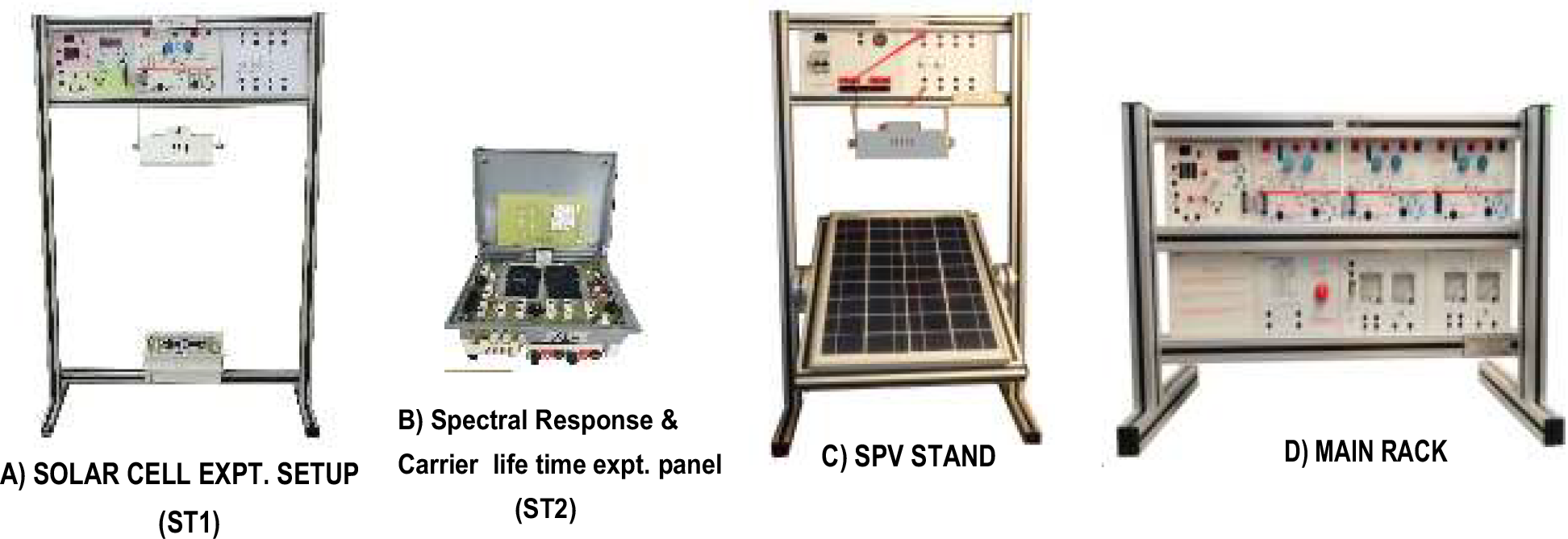
Order Code: TPO-TTT
Category: Physics Trainers
SALIENT FEATURES i) Basic model consisting of ST1 panel mounted in rack above (without peltier module) + ST3 + EMT8 & EMT9 panels + 500W lamp. ii) NISE/DGET compliant consisting of SPV stands (2 nos) with EMT8, EMT9 & Optimised rac...
SPECIFICATION
SALIENT FEATURES
- i) Basic model consisting of ST1 panel mounted in rack above (without peltier module) + ST3 + EMT8 & EMT9 panels + 500W lamp. ii) NISE/DGET compliant consisting of SPV stands (2 nos) with EMT8, EMT9 & Optimised rack with Rheostat + EMT68 (2 nos.) + ST3 + ST4 + EMT6 + ST5 + EMT7 + ST4A (Optional). iii) Advanced model consisting of (ii) above + (i) (with peltier module) and ST2 panel.
- Table top aluminum profile modular flat demo panel rack with tiltable lockable frame 0-90° in steps to mount various types of SPV modules. Employs 1000W halogen lamps as variable intensity sun simulator.
- NISE/DGET curriculum based laboratory experiments supported. Useful for laboratory experimental learning by students in renewable energy basics, energy conservation, charge controller, storage system etc.
- Optional single phase (Stand alone or Grid tied) inverter to demonstrate power export using bidirectional multifunction meter.
- Closed loop temperature control using peltier module to study temperature effect on solar cell characteristics.
- Panels ST1 and ST2 facilitates understanding of underlying physics by measuring carrier life time & spectral response of a solar cell & calibration. Removes dependance on costly pyranometer through use of calibration. Certificate from NISE delhi for solar cell supplied. (optional)
- Optionally table top electro-scopie and hand held solar power meter are supplied.
- Optionally IV curve tester & PC interface, Solar DC pump setup can be provided.
- Set of Instructor Guide & Student Workbook.
TECHNICAL SPECIFICATIONS
A) Solar cell experiment setup, needs three panels
Consists of table top aluminium profile rack (30x30) size:- 970(H) x 700(W) x 300(D) holding various panels
- Solar cell experiment panel (ST1)- 1 No.
- Mounted on horizontal member.
- 50 x 50 mm x 2 nos. crystalline silicon solar cells (3V/150mA) mounted in aluminium tray with heatsink and fan.
- Loading pots (500E and 5K).
- Series & parallel combination arrangement.
- Optionally cell temp controlled by Peltier module (40W), Foil type PT100 sensor to measure temperature, 12Vdc cooling Fan to maintain heatsink temp (Range 150C - 750C). Mechanical : 90(H) x 200(W) x 150(D) mm/ Net Wt.:- 8Kg
- Instrumentation power supply cum multichannel DPM panel (EMT8)- 1 No.
- DC Multi Output power supply.
- Provides 1 Ph. AC supply through 3 MCB's, 4A each to power up other panels in the rack.
- Multi channel DPM for temperature display.
- 20 pin FRC power bus to supply power to neighboring
- Green shrouded socket provided to extend earth
- SCR actuator cum sensor signal conditioning panel (EMT 9)- 1 No.
- SCR based AC controller to set intensity of halogen lamp.
- Supports signal conditioning circuit for temperature to give output 0-2.5Vdc.
- DC Application panel (ST3)
- Common 12V DC fan for both solar cell and SPV
- Separate LED lamps for 3V solar cell and 12V SPV
- 6V battery mounted from behind for solar cell
List of experiments
- Study of I-V Characteristics of Solar cell.
- Study of series combination of solar cells.
- Study of parallel combination of solar cells.
- Study of dependency of solar cell I-V characteristics on light intensity.
- Study of dependency of solar cell I-V characteristics on temperature.
- Study of shading effect on solar cell parameters.
- Study of Photovoltaic effect in ubiquitous semiconductor PN junction (diode).
- Study of 6V battery charging using solar cell
- Study of 6V battery discharging using DC fan & LED lamp
B) Spectral Response & Carrier Lifetime Measurement setup enables you to study physics of solar cell (ST2)
- Stand alone table top kit with built in +/- 12V power supply.
- 50 x 50 mm x 2 nos. crystalline silicon solar cells mounted in aluminium tray.
- 11 different wavelength LED’s @ constant 20 mA current to determine spectral response parameter. 1Pole/2W selector switch to select different wave length LEDs.
- White led bank of 8 LED’s to determine carrier life time parameter.
List of experiments
- Measurement of Carrier Lifetime for a solar cell.
- Measurement of Spectral Response for a solar cell.
Mechanical :- 120(H) x 200(W) x 150(D) mm
Net Wt.:- 2.5Kg
C) SPV Stand- 2 Nos.
- SPV module details (Specification subject to change)
- Instrumentation power supply cum multichannel DPM panel (EMT8)- 2 No.
- +12V, -12V, @500 mA. & +5V@300 mA.
- Multi channel DPM for temperature display.
- 20 pin FRC power bus to supply power to neighboring
- Green shrouded socket provided to extend earth
- u SCR actuator cum sensor signal conditioning panel (EMT 9)- 2 No.
- l SCR based AC controller to set intensity of halogen lamp.
- l Supports signal conditioning circuit for temperature to give output 0-2.5Vdc.
D) Main rack - 1 No.
Consists of table top aluminium profile rack (45x45) holding various panels
- DC Application panel (ST3)
- Common 12V DC fan for both solar cell and SPV
- Separate LED lamps for 3V solar cell and 12V SPV
- 6V battery mounted from behind for solar cell
- DC voltmeter & DC Ammeter panel (EMT68)- 2 nos.
- DC voltmeter (0-50V)
- DC ammeter (0-5A) with polarity protection diode.
- Stand-alone Inverter Panel (ST5)- 1 no
- I/P DC voltage-10-15Vdc, O/P AC voltage- 230Vac
- O/P power rating- 210 VA
- MPPT Charge Control Panel (ST4)- 1 no
- Rated voltage- 12Vdc, Max current- 6A
- Max PV voltage-15V
- Min PV voltage-10V
- Battery rated voltage- 12V, Capacity- 7Ah
- Battery type- Lead acid
- Lamp load panel (EMT7)- 1 no
- 230V/15/40/60/100W x 3 bulbs with individual ON/OFF using 6A toggle switches.
- AC voltmeter & AC ammeter panel (EMT6)- 1 no
- Voltmeter: 300V, Ammeter: 0.5A
- Rheostat as load for SPV modules (600E/1A)- 1 no
List of experiments : Covers NISE/ DGET course curriculum
- To study the I-V & P-V characteristics of PV module with varying radiation and temperature level
- To study the I-V & P-V characteristics of series combination of PV module
- To study the I-V & P-V characteristics of parallel combination of PV module
- To show the effect of variation in tilt angle on module power
- To demonstrate effect of shading on module output power
- To demonstrate the working of diode as blocking diode
- To draw charging and discharging characteristics of battery
- Observe the O/P waveform of inverter in auto mode
- Workout power flow calculations of standalone PV system AC load with battery
- Workout power flow calculation of standalone PV system DC load with battery
- Find MPP by varying the resistive load across the PV panel
- To study effect of shading on the O/P of solar panel
- To do shading analysis on the site where solar PV systems to be setup
- Battery characteristics: To study battery characteristics by finding out battery capacity (Ah) based on manufacturers data & discharging curve (Cxx) experimentally.
- To understand difference between MPPT & PWM charge controllers, efficiency of MPPT & PWM charge controller & energy flow in a system involving MPPT & PWM charge controller
- To understand and determine the DC flow in a solar system
- To understand how a solar PV standalone system works
- To determine power flow in a solar system
- To convert normal inverter to a solar inverter system
- To compare the performance of two inverters using electro-scopie (Optional)
- IV/PV characteristics of PV module on PC screen using VWB software, MPPT controller or data logger with its built in calculator & graph window/ IV Curve Tester (Optional)
- To perform experiment of MPPT charge controller using ST8 panel & VWB software with following algorithms/ schemes (Optional) i) Incremental Conductance ii) Perturb and Observe iii) 75% of VOC
- Optional DC solar pump experiment needs separate setup containing DC pump, rotameter, turbine sensor, EMT68 panel.
E) Optional PC interface - STT needs following additional panels: ST8, CIP-II & one more EMT8 panel.
- MPPT charge controller Panel (ST8)- 1 no
- 2 IGBT modules, 1st for charging control & 2nd for load ON/OFF
- 5 nos of analog outputs AI (0-2.5V) for RE voltage, RE current, Battery voltage, Irradiance measurement & Load/ battery voltage
- 2 nos of DAC inputs for PWM control and load ON/OFF
- Built in battery- 12V/7Ah, Type: Lead acid
- Computer interface Panel (CIP-II)- 1 no
- Connects to PC (Win7/8/10) USB port through USB IO module & type A to mini B cable
- 8 ADC channels I/P: 0 to 2.5V FS with 1 no. input simulation pot. 2 DAC channels O/P 0-2.5V FS
- V to I function block: I/P 0 to 2.5V and O/P 0-20 or 4-20mA (100 ohm load) switch settable.
- I to V function block: I/P 4 to 20mA and O/P 0-2.5V
- USB converter to interface 25 pin D connector on CIP panel to USB enclosed in 25 pin D shell using type A to mini B type cable
- Software on CD
- Virtual Workbench (VWB) software package is a USB based software working on windows .net platform coupled with USB IO module useful as general purpose S/W utility which supports different control strategies like graph plotting in XY, MPPT controller etc.
Mechanical : 545(H) x 960(W) x 300(D) mm,
Net Wt.:- 35Kg, Gross Wt.:- 45Kg.

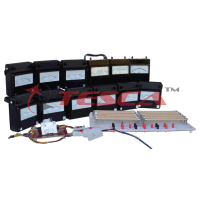
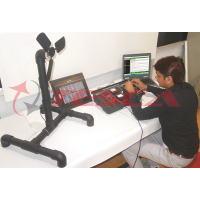
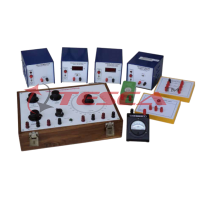
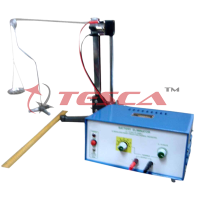
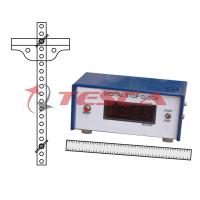
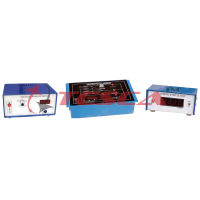
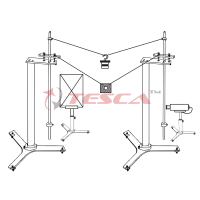
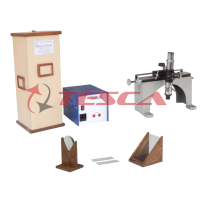
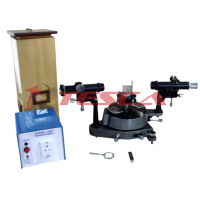

 91-9829132777
91-9829132777